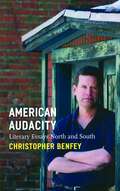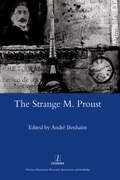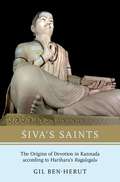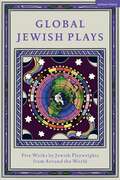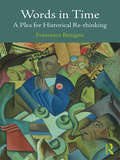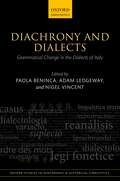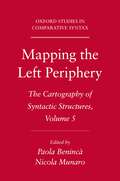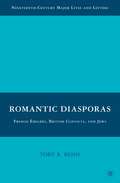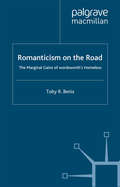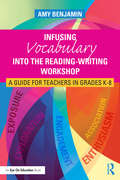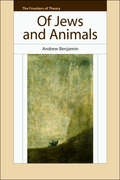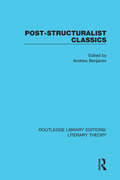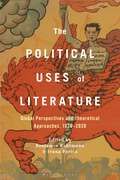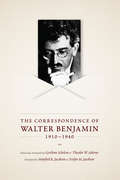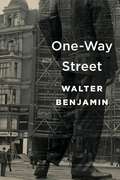- Table View
- List View
American Audacity: Literary Essays North and South (Writers On Writing)
by Christopher BenfeyOne of the foremost critics in contemporary American letters, Christopher Benfey has long been known for his brilliant and incisive essays. Appearing in such publications as the New York Review of Books, the New Republic, and the Times Literary Supplement, Benfey's writings have helped us reimagine the American literary canon. In American Audacity, Benfey gathers his finest writings on eminent American authors (including Emerson, Dickinson, Whitman, Millay, Faulkner, Frost, and Welty), bringing to his subjects---as the New York Times Book Review has said of his earlier work---"a scholar's thoroughness, a critic's astuteness and a storyteller's sense of drama." Although Benfey's interests range from art to literature to social history, this collection focuses on particular American writers and the various ways in which an American identity and culture inform their work. Broken into three sections, "Northerners,""Southerners," and "The Union Reconsidered," American Audacity explores a variety of canonical works, old (Emerson, Dickinson, Millay, Whitman), modern (Faulkner, Dos Passos), and more contemporary (Gary Snyder, E. L. Doctorow). Christopher Benfey is the author of numerous highly regarded books, including Emily Dickinson: Lives of a Poet; The Double Life of Stephen Crane; Degas in New Orleans: Encounters in the Creole World of Kate Chopin and George Washington Cable; and, most recently, The Great Wave: Gilded Age Misfits, Japanese Eccentrics, and the Opening of Old Japan. Benfey's poems have appeared in the Paris Review, Pequod, and Ploughshares. He has held fellowships from the Guggenheim Foundation, the National Endowment for the Humanities, and the American Council of Learned Societies. Currently he is Mellon Professor of English at Mount Holyoke College. "In its vigorous and original criticism of American writers, Christopher Benfey's American Audacity displays its own audacities on every page." ---William H. Pritchard
The Strange M. Proust
by Andre BenhaimThe strange M. Proust - the narrator, the author, and the embodiment of A la Recherche du Temps perdu - is now so canonical a writer that his very strangeness is easily overlooked. His book made of other books, his epic composed of extraordinary miniatures, his orderly structure where every law is subverted, his chronology where time can be undone and his geography where places can superimpose: in these, and many other ways, Proust continues to astonish even readers who have engaged with him for their entire careers. In this book, arising from the Princeton symposium of 2006, major critics come together to offer provocative readings of a work which is at the same time classical and unusual, French and foreign, familiar and strange. The book is dedicated to the memory of Malcolm Bowie (1943-2007), whose keynote address was one of his last major lectures. Other contributors include David Ellison, Anne Simon, Eugene Nicole, Joseph Brami, Raymonde Coudert, Christie McDonald, Michael Wood and Antoine Compagnon.
The Strange M. Proust
by Andre BenhaimThe strange M. Proust - the narrator, the author, and the embodiment of A la Recherche du Temps perdu - is now so canonical a writer that his very strangeness is easily overlooked. His book made of other books, his epic composed of extraordinary miniatures, his orderly structure where every law is subverted, his chronology where time can be undone and his geography where places can superimpose: in these, and many other ways, Proust continues to astonish even readers who have engaged with him for their entire careers. In this book, arising from the Princeton symposium of 2006, major critics come together to offer provocative readings of a work which is at the same time classical and unusual, French and foreign, familiar and strange. The book is dedicated to the memory of Malcolm Bowie (1943-2007), whose keynote address was one of his last major lectures. Other contributors include David Ellison, Anne Simon, Eugene Nicole, Joseph Brami, Raymonde Coudert, Christie McDonald, Michael Wood and Antoine Compagnon.
Siva's Saints: The Origins of Devotion in Kannada according to Harihara's Ragalegalu
by Gil Ben-HerutComprising more than twelve million people and renowned for their resistance to Brahminical values, the Virasaivas are a vibrant and unorthodox religious community with a provocative socio-political voice. The Virasaiva tradition has produced a vast and original body of literature, composed mostly in Kannada, a Dravidian language from south India. Siva's Saints introduces a previously unexplored and central primary work produced in the early thirteenth century, the Ragalegalu. This was the first narrative text written about the incipient devotional tradition dedicated to the god Siva in the Kannada-speaking regions; through stories of the saints, it images the life of this new religious community. The Ragalegalu inaugurated a new era in the production of devotional narratives accessible to wide audiences. Gil Ben-Herut challenges common notions about this tradition in its nascent phases. By closely reading the saints' stories in this text, Siva's Saints takes a more nuanced historical view than commonly-held notions about the egalitarian and iconoclastic nature of the early tradition, arguing instead that early bhakti (devotionalism) in the Kannada-speaking region was less-radical and more accommodating toward traditional religious, social, and political institutions than thought of today. In contrast to the narrowly sectarian and exclusionary vision that shapes later accounts, the Ragalegalu is characterized by an opposite impulse of offering an open invitation to people from all walks of life, and their stories illustrate the richness of their devotional lives. Analysis of this seminal text yields important insights into the role of literary representation of the social and political development of a religious community in a pre-modern and non-Western milieu.
Siva's Saints: The Origins of Devotion in Kannada according to Harihara's Ragalegalu
by Gil Ben-HerutComprising more than twelve million people and renowned for their resistance to Brahminical values, the Virasaivas are a vibrant and unorthodox religious community with a provocative socio-political voice. The Virasaiva tradition has produced a vast and original body of literature, composed mostly in Kannada, a Dravidian language from south India. Siva's Saints introduces a previously unexplored and central primary work produced in the early thirteenth century, the Ragalegalu. This was the first narrative text written about the incipient devotional tradition dedicated to the god Siva in the Kannada-speaking regions; through stories of the saints, it images the life of this new religious community. The Ragalegalu inaugurated a new era in the production of devotional narratives accessible to wide audiences. Gil Ben-Herut challenges common notions about this tradition in its nascent phases. By closely reading the saints' stories in this text, Siva's Saints takes a more nuanced historical view than commonly-held notions about the egalitarian and iconoclastic nature of the early tradition, arguing instead that early bhakti (devotionalism) in the Kannada-speaking region was less-radical and more accommodating toward traditional religious, social, and political institutions than thought of today. In contrast to the narrowly sectarian and exclusionary vision that shapes later accounts, the Ragalegalu is characterized by an opposite impulse of offering an open invitation to people from all walks of life, and their stories illustrate the richness of their devotional lives. Analysis of this seminal text yields important insights into the role of literary representation of the social and political development of a religious community in a pre-modern and non-Western milieu.
Global Jewish Plays: Extinct; Heartlines; The Kahena Berber Queen; Papa’gina; A People (Methuen Drama Play Collections)
by Berthe Bénichou-Aboulker Hana Vazana Grunwald Sarah Waisvisz Philip Arditti L M FeldmanA unique collection of plays that brings together stories of Jewish life from playwrights around the world. Curated and edited by an international theatre collective, these five plays showcase the dazzling multiplicity of Jewish narratives across the globe: the haunting, the challenging, the joyful. From a legendary North African warrior queen to queer French avant-garde artists during World War II; from Israel-Palestine tensions made personal to protests in Istanbul amidst intergenerational trauma, this is a genre-spanning collection that probes at the heart of what it means to be Jewish - past, present, and future. Curated by Jewish-Lebanese Brazilian queer theatre maker, the plays were performed at London's Bush Theatre as part of Global Voices Theatre's popular live events. At a sensitive time for Jewish communities in the UK and beyond, the original event Global Jewish Voices aimed to engage the UK Jewish community and make space for nuanced conversations and representation. This collection of selected plays is a legacy of the event and opens up avenues for wider audiences to read and perform the works.
Global Jewish Plays: Extinct; Heartlines; The Kahena Berber Queen; Papa’gina; A People (Methuen Drama Play Collections)
by Berthe Bénichou-Aboulker Hana Vazana Grunwald Sarah Waisvisz Philip Arditti L M FeldmanA unique collection of plays that brings together stories of Jewish life from playwrights around the world. Curated and edited by an international theatre collective, these five plays showcase the dazzling multiplicity of Jewish narratives across the globe: the haunting, the challenging, the joyful. From a legendary North African warrior queen to queer French avant-garde artists during World War II; from Israel-Palestine tensions made personal to protests in Istanbul amidst intergenerational trauma, this is a genre-spanning collection that probes at the heart of what it means to be Jewish - past, present, and future. Curated by Jewish-Lebanese Brazilian queer theatre maker, the plays were performed at London's Bush Theatre as part of Global Voices Theatre's popular live events. At a sensitive time for Jewish communities in the UK and beyond, the original event Global Jewish Voices aimed to engage the UK Jewish community and make space for nuanced conversations and representation. This collection of selected plays is a legacy of the event and opens up avenues for wider audiences to read and perform the works.
Words in Time: A Plea for Historical Re-thinking
by Francesco BenignoThrough questions such as ‘What is power?’, ‘How are revolutions generated?’, ‘Does public opinion really exist?’, ‘What does terrorism mean?’ and ‘When are generations created?’, Words in Time scrutinizes the fundamental concepts by which we confer meaning to the historical and social world and what they actually signify, analysing their formation and use in modern thought within both history and the social sciences. In this volume, Francesco Benigno examines the origins and development of the words we use, critiquing the ways in which they have traditionally been employed in historical thinking and examining their potential usefulness today. Rather than being a general inventory or a specialized dictionary, this book analyses a selection of words particularly relevant not only in the idiom and jargon of the social sciences and history, but also in the discourse of ordinary people. Exploring new trends in the historical field of reflection and representing a call for a new, more conscious, historical approach to the social world, this is valuable reading for all students of historical theory and method.
Words in Time: A Plea for Historical Re-thinking
by Francesco BenignoThrough questions such as ‘What is power?’, ‘How are revolutions generated?’, ‘Does public opinion really exist?’, ‘What does terrorism mean?’ and ‘When are generations created?’, Words in Time scrutinizes the fundamental concepts by which we confer meaning to the historical and social world and what they actually signify, analysing their formation and use in modern thought within both history and the social sciences. In this volume, Francesco Benigno examines the origins and development of the words we use, critiquing the ways in which they have traditionally been employed in historical thinking and examining their potential usefulness today. Rather than being a general inventory or a specialized dictionary, this book analyses a selection of words particularly relevant not only in the idiom and jargon of the social sciences and history, but also in the discourse of ordinary people. Exploring new trends in the historical field of reflection and representing a call for a new, more conscious, historical approach to the social world, this is valuable reading for all students of historical theory and method.
Diachrony And Dialects: Grammatical Change In The Dialects Of Italy (Oxford Studies in Diachronic and Historical Linguistics #8)
by Paola Benincà Adam Ledgeway Nigel VincentThis book examines diachronic change and diversity in the morphosyntax of Romance varieties spoken in Italy. These varieties offer an especially fertile terrain for research into language change, because of both the richness of dialectal variation and the length of the period of textual attestation. While attention in the past has been focussed on the variation found in phonology, morphology, and vocabulary, this volume examines variation in morphosyntactic structures, covering a range of topics designed to exploit and explore the interaction of the geographical and historical dimensions of change. The opening chapter sets the scene for specialist and non-specialist readers alike, and establishes the conceptual and empirical background. There follow a series of case studies investigating the morphosyntax of verbal and (pro)nominal constructions and the organization of the clause. Data are drawn from the full range of Romance dialects spoken within the borders of modern Italy, ranging from Sicily and Sardinia through to Piedmont and Friuli. Some of the studies narrow the focus to a particular construction within a particular dialect; others broaden out to compare different patterns of evolution within different dialects. There is also diversity in the theoretical frameworks adopted by the various contributors. The book aims to take stock of both the current state of the field and the fruits of recent research, and to set out new results and new questions to help move forward the frontiers of that research. It will be a valuable resource not only for those specializing in the study of Italo-Romance varieties, but also for other Romanists and for those interested in exploring and understanding the mechanisms of morphosyntactic change more generally.
Mapping Left Periphery Vol 5 Oscs C: The Cartography Of Syntactic Structures, Volume 5
by Paola Beninca Nicola MunaroMapping the Left Periphery: The Cartography of Syntactic Structures, Volume 5 (Oxford Studies in Comparative Syntax)
by Paola Beninca Nicola MunaroMapping the Left Periphery, the fifth volume in "The Cartography of Syntactic Structures," is entirely devoted to the functional articulation of the so-called complementizer system, the highest part of sentence structure. The papers collected here identify, on the basis of substantial empirical evidence, new atoms of functional structure, which encode specific features that are typically expressed in the left periphery. The volume also submits the richly articulated CP structure to further crosslinguistic checking. The research presented here has led to the identification of new, important restrictions in the relative sequence of elements appearing in the left periphery. With contributions from African languages, Chinese, Hungarian, Romance languages, and Italian dialects, Mapping the Left Periphery will be of interest to syntacticians working on comparative syntax, and more specifically on Romance grammar.
Romantic Diasporas: French Émigrés, British Convicts, and Jews (Nineteenth-Century Major Lives and Letters)
by T. BenisRomantic Diasporasexamines exile in the Romantic period fromthe different perspectives of French émigrés in England, British convicts transported to Australia, and Jews in their perennial diaspora.
Romanticism on the Road: The Marginal Gains of Wordsworth's Homeless (Romanticism in Perspective:Texts, Cultures, Histories)
by T. BenisRomanticism on the Road challenges critical orthodoxy by arguing that Wordsworth rejected the political dogmas of his age. Refusing to ally with either radicals or conservatives after the French Revolution, the poet seizes on vagrants to attack the binary thinking dominating public affairs and to question the value of the Georgian domestic ideal. Drawing on current and historical discussions of homelessness, the study offers a cultural history of vagrancy and explains why Wordsworth chose the homeless to bear his message.
Infusing Vocabulary Into the Reading-Writing Workshop: A Guide for Teachers in Grades K-8
by Amy BenjaminLearn how to make vocabulary instruction more effective by making better use of mini-lessons and word study time to achieve durable learning about words and how they work. In this essential new book, literacy expert Amy Benjamin presents her 4E model (Exposure, Exploration, Engagement, Energy) for teaching vocabulary so that students gain deep understanding, improving their overall language and literacy skills. Benjamin guides you through bringing these 4Es to life in your K-8 reading-writing workshop. -Exposure: Enrich your teacher talk with sophisticated words and phrases to facilitate natural language acquisition and application of new words. -Exploration: Promote consistent vocabulary growth with a multifaceted instructional approach that incorporates etymology, word associations, word families, spelling, and morphology. -Engagement: Build students’ confidence by encouraging meaningful use of new words, both in and out of the classroom. -Energy: Enliven your workshop and increase participation with a variety of word games, puzzles, projects, and cooperative learning activities. Each chapter provides practical examples and scenarios to help you apply the model to your own classroom. The appendices include a variety of strategies for organizing reading-writing workshops, a thorough introduction to academic word lists and their role in vocabulary instruction, and an analysis of forty Latin and Greek word roots for mini-lessons.
Infusing Vocabulary Into the Reading-Writing Workshop: A Guide for Teachers in Grades K-8
by Amy BenjaminLearn how to make vocabulary instruction more effective by making better use of mini-lessons and word study time to achieve durable learning about words and how they work. In this essential new book, literacy expert Amy Benjamin presents her 4E model (Exposure, Exploration, Engagement, Energy) for teaching vocabulary so that students gain deep understanding, improving their overall language and literacy skills. Benjamin guides you through bringing these 4Es to life in your K-8 reading-writing workshop. -Exposure: Enrich your teacher talk with sophisticated words and phrases to facilitate natural language acquisition and application of new words. -Exploration: Promote consistent vocabulary growth with a multifaceted instructional approach that incorporates etymology, word associations, word families, spelling, and morphology. -Engagement: Build students’ confidence by encouraging meaningful use of new words, both in and out of the classroom. -Energy: Enliven your workshop and increase participation with a variety of word games, puzzles, projects, and cooperative learning activities. Each chapter provides practical examples and scenarios to help you apply the model to your own classroom. The appendices include a variety of strategies for organizing reading-writing workshops, a thorough introduction to academic word lists and their role in vocabulary instruction, and an analysis of forty Latin and Greek word roots for mini-lessons.
Of Jews and Animals (The Frontiers of Theory)
by Andrew BenjaminIn developing his own conception of the 'figure', Andrew Benjamin has written an innovative and provocative study of the complex relationship between philosophy, the history of painting and their presentation of both Jews and animals. Newly available in paperback.
Post-Structuralist Classics (Routledge Library Editions: Literary Theory)
by Andrew BenjaminModern literary theory is increasingly looking to philosophy for its inspiration. After a wave of structural analysis, the growing influence of deconstruction and hermeneutic readings continues to bear witness to this. This exciting and important collection, first published in 1988, reveals the diversity of approaches that mark the post-structuralist endeavour, and provides a challenge to the conventional practice of classical studies and ancient philosophy. This book will be of interest to students of ancient philosophy, classical studies and literary theory.
Post-Structuralist Classics (Routledge Library Editions: Literary Theory)
by Andrew BenjaminModern literary theory is increasingly looking to philosophy for its inspiration. After a wave of structural analysis, the growing influence of deconstruction and hermeneutic readings continues to bear witness to this. This exciting and important collection, first published in 1988, reveals the diversity of approaches that mark the post-structuralist endeavour, and provides a challenge to the conventional practice of classical studies and ancient philosophy. This book will be of interest to students of ancient philosophy, classical studies and literary theory.
The Political Uses of Literature: Global Perspectives and Theoretical Approaches, 1920-2020
by Benjamin Kohlmann and Ivana PericaDrawing on a global history of politicized writing, this book explores literature's utility as a mode of activism and aesthetic engagement with the political challenges of the current moment.The question of literature's 'uses' has recently become a key topic of academic and public debate. Paradoxically, however, these conversations often tend to bypass the rich history of engagements with literature's distinctly political uses that form such a powerful current of 20th- and 21st-century artistic production and critical-theoretical reflection. The Political Uses of Literature reopens discussion of literature's political and activist genealogies along several interrelated lines: As a foundational moment, it draws attention to the important body of interwar politicized literature and to debates about literature's ability to intervene in social reality. It then traces the mobilization of related conversations and artistic practices across several historical conjunctures, most notably the committed literature of the 1960s and our own present. In mapping out these geographically and artistically diverse traditions – including case studies from the Americas, Europe, Africa, India and Russia – contributors advance critical discussions in the field, making questions pertaining to politicized art newly compelling to a broader and more diverse readership. Most importantly, this volume insists on the need to think about literature's political uses today – at a time when it has become increasingly difficult to imagine any kind of political efficacy for art, even as the need to do so is growing more and more acute. Literature may not proffer easy answers to our political problems, but as this collection suggests, the writing of the 20th century holds out aesthetic resources for a renewed engagement with the dilemmas that face us now.
The Correspondence of Walter Benjamin, 1910-1940
by Walter BenjaminCalled “the most important critic of his time” by Hannah Arendt, Walter Benjamin has only become more influential over the years, as his work has assumed a crucial place in current debates over the interactions of art, culture, and meaning. A “natural and extraordinary talent for letter writing was one of the most captivating facets of his nature,” writes Gershom Scholem in his Foreword to this volume; and Benjamin's correspondence reveals the evolution of some of his most powerful ideas, while also offering an intimate picture of Benjamin himself and the times in which he lived. Writing at length to Scholem and Theodor Adorno, and exchanging letters with Rainer Maria Rilke, Hannah Arendt, Max Brod, and Bertolt Brecht, Benjamin elaborates on his ideas about metaphor and language. He reflects on literary figures from Kafka to Karl Kraus, and expounds his personal attitudes toward such subjects as Marxism and French national character. Providing an indispensable tool for any scholar wrestling with Benjamin’s work, The Correspondence of Walter Benjamin, 1910–1940 is a revelatory look at the man behind much of the twentieth century’s most significant criticism.
The Correspondence of Walter Benjamin, 1910-1940
by Walter BenjaminCalled “the most important critic of his time” by Hannah Arendt, Walter Benjamin has only become more influential over the years, as his work has assumed a crucial place in current debates over the interactions of art, culture, and meaning. A “natural and extraordinary talent for letter writing was one of the most captivating facets of his nature,” writes Gershom Scholem in his Foreword to this volume; and Benjamin's correspondence reveals the evolution of some of his most powerful ideas, while also offering an intimate picture of Benjamin himself and the times in which he lived. Writing at length to Scholem and Theodor Adorno, and exchanging letters with Rainer Maria Rilke, Hannah Arendt, Max Brod, and Bertolt Brecht, Benjamin elaborates on his ideas about metaphor and language. He reflects on literary figures from Kafka to Karl Kraus, and expounds his personal attitudes toward such subjects as Marxism and French national character. Providing an indispensable tool for any scholar wrestling with Benjamin’s work, The Correspondence of Walter Benjamin, 1910–1940 is a revelatory look at the man behind much of the twentieth century’s most significant criticism.
The Correspondence of Walter Benjamin, 1910-1940
by Walter BenjaminCalled “the most important critic of his time” by Hannah Arendt, Walter Benjamin has only become more influential over the years, as his work has assumed a crucial place in current debates over the interactions of art, culture, and meaning. A “natural and extraordinary talent for letter writing was one of the most captivating facets of his nature,” writes Gershom Scholem in his Foreword to this volume; and Benjamin's correspondence reveals the evolution of some of his most powerful ideas, while also offering an intimate picture of Benjamin himself and the times in which he lived. Writing at length to Scholem and Theodor Adorno, and exchanging letters with Rainer Maria Rilke, Hannah Arendt, Max Brod, and Bertolt Brecht, Benjamin elaborates on his ideas about metaphor and language. He reflects on literary figures from Kafka to Karl Kraus, and expounds his personal attitudes toward such subjects as Marxism and French national character. Providing an indispensable tool for any scholar wrestling with Benjamin’s work, The Correspondence of Walter Benjamin, 1910–1940 is a revelatory look at the man behind much of the twentieth century’s most significant criticism.
One-Way Street: And Other Writings (Penguin Modern Classics Series #966)
by Walter BenjaminPresented in a new edition with expanded notes, this genre-defying meditation on the semiotics of late-1920s Weimar culture, composed of 60 short prose pieces that vary wildly in style and theme, offers a fresh opportunity to encounter Walter Benjamin at his most virtuosic and experimental, writing in a vein that anticipates later masterpieces.
One-Way Street
by Walter BenjaminPresented in a new edition with expanded notes, this genre-defying meditation on the semiotics of late-1920s Weimar culture, composed of 60 short prose pieces that vary wildly in style and theme, offers a fresh opportunity to encounter Walter Benjamin at his most virtuosic and experimental, writing in a vein that anticipates later masterpieces.
